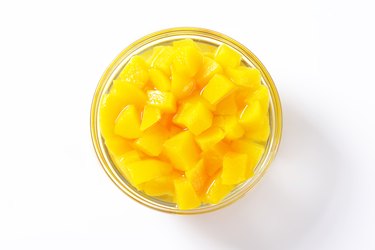
When you're trying to lose belly fat, naturally sweet fruit can be a great replacement for sugary treats. But some fruits are better for weight loss than others. Sweetened dried fruit and fruit packed in syrup should be off limits, while tropical fruits should be eaten in moderation.
Avoid Syrupy Canned Fruit
Video of the Day
If you're going to buy fruit, you should almost always get fresh fruit from the produce section. Unsweetened frozen fruit is also a good choice. Fruit you find in the unrefrigerated aisles of your supermarket is preserved — either canned, dried or dehydrated. While not all of these are terrible choices, they're not as good for weight loss as fresh or frozen fruit.
Video of the Day
Canned fruit comes in a few varieties, including packed in water, juice or syrup. Fruits canned in syrup are by far the worst of the bunch, due to their added sugar content and, thus, higher calorie count. For example, according to USDA data, 1 cup of pears canned in heavy syrup has 197 calories and a whopping 40 grams of sugar.
While some of that is natural fruit sugars, much is added sugar, which is a major concern when you're trying to lose belly fat — or just trying to improve your health. According to the Centers for Disease Control and Prevention, too much added sugar in the diet can lead to weight gain, obesity, type 2 diabetes and heart disease. To avoid these consequences, the CDC recommends a maximum of 10 percent of total calories from added sugar. If you're eating 1,800 calories, that's no more than 180 calories from sugar per day — or the equivalent of 45 grams.
Fruit canned in juice isn't much better. One cup of pears canned in juice has 122 calories and 28 grams of sugar, about half of which is added sugar. If you're going to eat canned fruit, water-packed is your healthiest choice. With nearly a third of the amount of calories and sugar as pears packed in syrup, a cup of pears canned in water won't break the calorie and added sugar bank.
Be Careful With Dried Fruit
Another type of fruit you'll find in the aisles is dried fruit. It's chewy, sweet and can almost stand in for your favorite chewy candy — which is exactly why you must exercise caution. Even though dried fruit contains natural sugars, when all the water is removed, those sugars become very concentrated.
Just a small amount of dried fruit can add up to a lot of calories. For example, 1/2 cup of dried mango has 140 calories, according to the USDA. Raisins are very high in sugar, with 48 grams and 240 calories per half-cup.
An even bigger problem is that many varieties of dried fruit contain added sugar. Cranberries, for example, are almost always sweetened because they are naturally quite sour. One-half cup of dried, sweetened dried, sweetened cranberries has 280 calories and almost 60 grams of sugar. But even naturally sweet dried fruits like mango may have sugar added during processing.
If you are going to eat dried fruit, it is important to stick to a single serving, which is 1/4 cup, according to the American Heart Association, and avoid those with added sugar.
Fresh Is Best
There really is not a list of five, or any number, of specific fruits to avoid when trying to lose belly fat, but fresh fruits, whatever they are, are always best.
For example, compared to a fresh, raw pear, canned pears have less fiber because their skins are removed before canning. They also have fewer vitamins and minerals. In a pinch, a serving of canned fruit in water is OK, but whenever possible, reach for fresh.
Your best fruit choices when you're on a diet are those that are lowest in sugar and highest in fiber. Raspberries are a perfect example, with 64 calories and a generous 8 grams of fiber per cup. Blueberries are another good choice with 84 calories and 3.5 grams of fiber per cup.
Other fruits are higher in sugar and lower in fiber and are best eaten in moderation when you're on a diet. These include tropical fruits, such as fresh banana and fresh mango. With a little less fiber and more calories and sugar, it's best to save these for a treat or right after a tough workout when you need some quick carbs.
Creamy, mild avocados are full of heart-healthy fats, but all that fat means they are high in calories. One California avocado has 218 calories, per USDA data. It's definitely worth including avocado in your diet, but don't exceed the recommended serving size, which is one-half of a medium fruit.
Read more: Top 10 Healthiest Fruits & Vegetables
- USDA: "Pear, Cooked or Canned, in Heavy Syrup"
- CDC: "Know Your Limit for Added Sugars"
- USDA: "Pear, Cooked or Canned, Juice Pack"
- USDA: "Pear, Cooked or Canned, Unsweetened, Water Pack"
- USDA: "Dried Mango"
- USDA: "Raisins"
- USDA: "Dried Cranberries"
- American Heart Association: "Fruits and Vegetables Serving Sizes"
- USDA: "Pear, Raw"
- USDA: "Avocado, Raw"
- USDA: "Mango"
- USDA: "Banana, Raw"
- USDA: "Raspberries"
- USDA: "Blueberries"
Was this article helpful?
150 Characters Max
0/150
Thank you for sharing!
Thank you for your feedback!